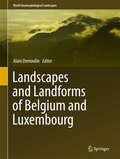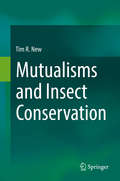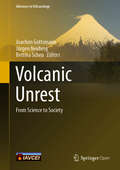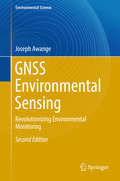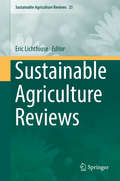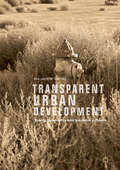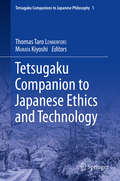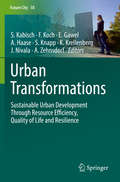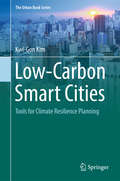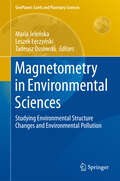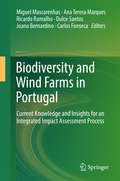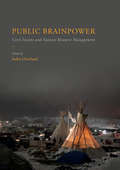- Table View
- List View
Landscapes and Landforms of Belgium and Luxembourg (World Geomorphological Landscapes)
by Alain DemoulinThis book provides an informative and intriguing overview of the most scenic landscapes of Belgium and Luxembourg. Geodiversity is emphasized, for example the periglacial features in the Hautes Fagnes area, the planation surfaces in the Ardennes and Oesling, and the famous caves of Han/Lesse and Remouchamps. The book’s chief goals are to provide the reader with enjoyable and informative descriptions of the selected sites within their regional geographical and geological settings; to offer an up-to-date survey of the evolution of Belgium’s and Luxembourg’s landscape; and to share additional information on the cultural value of the respective sites wherever appropriate. The book is a richly illustrated reference work that makes accessible for the first time a wealth of information currently scattered among many national and regional journals. It will benefit earth scientists, environmental scientists, tourism geographers and conservationists alike.
Mutualisms and Insect Conservation
by Tim R. NewDocumenting and understanding intricate ecological interactions involving insects is a central need in conservation, and the specialised and specific nature of many such associations is displayed in this book. Their importance is exemplified in a broad global overview of a major category of interactions, mutualisms, in which the interdependence of species is essential for their mutual wellbeing. The subtleties that sustain many mutualistic relationships are still poorly understood by ecologists and conservation managers alike. Examples from many parts of the world and ecological regimes demonstrate the variety of mutualisms between insect taxa, and between insects and plants, in particular, and their significance in planning and undertaking insect conservation – of both individual species and the wider contexts on which they depend. Several taxonomic groups, notably ants, lycaenid butterflies and sucking bugs, help to demonstrate the evolution and flexibility of mutualistic interactions, whilst fundamental processes such as pollination emphasise the central roles of, often, highly specific partnerships. This compilation brings together a wide range of relevant cases and contexts, with implications for practical insect conservation and increasing awareness of the roles of co-adaptations of behaviour and ecology as adjuncts to designing optimal conservation plans. The three major themes deal with the meanings and mechanisms of mutualisms, the classic mutualisms that involve insect partners, and the environmental and conservation lessons that flow from these and have potential to facilitate and improve insect conservation practice. The broader ecological perspective advances the transition from primary focus on single species toward consequently enhancing wider ecological contexts in which insect diversity can thrive.
Volcanic Unrest: From Science To Society (Advances In Volcanology Ser.)
by Joachim Gottsmann Jürgen Neuberg Bettina ScheuThis open access book summarizes the findings of the VUELCO project, a multi-disciplinary and cross-boundary research funded by the European Commission's 7th framework program. It comprises four broad topics:1. The global significance of volcanic unrest2. Geophysical and geochemical fingerprints of unrest and precursory activity3. Magma dynamics leading to unrest phenomena4. Bridging the gap between science and decision-makingVolcanic unrest is a complex multi-hazard phenomenon. The fact that unrest may, or may not lead to an imminent eruption contributes significant uncertainty to short-term volcanic hazard and risk assessment. Although it is reasonable to assume that all eruptions are associated with precursory activity of some sort, the understanding of the causative links between subsurface processes, resulting unrest signals and imminent eruption is incomplete. When a volcano evolves from dormancy into a phase of unrest, important scientific, political and social questions need to be addressed. This book is aimed at graduate students, researchers of volcanic phenomena, professionals in volcanic hazard and risk assessment, observatory personnel, as well as emergency managers who wish to learn about the complex nature of volcanic unrest and how to utilize new findings to deal with unrest phenomena at scientific and emergency managing levels. This book is open access under a CC BY license.
GNSS Environmental Sensing: Revolutionizing Environmental Monitoring (Environmental Science and Engineering)
by Joseph AwangeThis book is the second edition of Environmental Monitoring using GNSS and highlights the latest developments in global navigation satellite systems (GNSS). It features a completely new title and additional chapters that present emerging challenges to environmental monitoring—“climate variability/change and food insecurity.” Since the publication of the first edition, much has changed in both the development and applications of GNSS, a satellite microwave remote sensing technique. It is the first tool to span all four dimensions of relevance to humans (position, navigation, timing and the environment), and it has widely been used for positioning (both by military and civilians), navigation and timing. Its increasing use is leading to a new era of remote sensing that is now revolutionizing the art of monitoring our environment in ways never imagined before.On the one hand, nearly all GNSS satellites (Global Positioning System (GPS), Global Navigation Satellite System (GLONASS), Galileo and Beidou) have become operational, thereby providing high-precision, continuous, all-weather and near real- time remote sensing multi-signals beneficial to environmental monitoring. On the other hand, the emerging challenges of precisely monitoring climate change and the demand for the production of sufficient food for ever-increasing populations are pushing traditional monitoring methods to their limits.In this regard, refracted GNSS signals (i.e., occulted GNSS signals or GNSS meteorology) are now emerging as sensors of climate variability, while the reflected signals (GNSS reflectometry or GNSS-R) are increasingly finding applications in determining, e.g., soil moisture content, ice and snow thickness, ocean heights, and wind speed and direction, among others. Furthermore, the increasing recognition and application of GNSS-supported unmanned aircraft vehicles (UAV)/drones in agriculture (e.g., through the determination of water holding capacity of soil) highlights the new challenges facing GNSS.As such, this new edition three new chapters address GNSS reflectometry and applications; GNSS sensing of climate variability; and the applications in UAV/drones. Moreover, it explores the application of GNSS to support integrated coastal zone management.
Sustainable Agriculture Reviews: Volume 18 (Sustainable Agriculture Reviews #25)
by Eric LichtfouseThis book deals with a rapidly growing field aiming at producing food and energy in a sustainable way for humans and their children. It is a discipline that addresses current issues: climate change, increasing food and fuel prices, poor-nation starvation, rich-nation obesity, water pollution, soil erosion, fertility loss, pest control and biodiversity depletion. This series gathers review articles that analyze current agricultural issues and knowledge, then proposes alternative solutions.
Resilience: From Accident Mitigation to Resilient Society Facing Extreme Situations
by Joonhong Ahn Franck Guarnieri Kazuo FurutaThis book is published open access under a CC BY 4.0 license. This book summarizes presentations and discussions from the two-day international workshop held at UC Berkeley in March 2015, and derives questions to be addressed in multi-disciplinary research toward a new paradigm of nuclear safety. The consequences of the Fukushima Daiichi nuclear accident in March 2011 have fuelled the debate on nuclear safety: while there were no casualties due to radiation, there was substantial damage to local communities. The lack of common understanding of the basics of environmental and radiological sciences has made it difficult for stakeholders to develop effective strategies to accelerate recovery, and this is compounded by a lack of effective decision-making due to the eroded public trust in the government and operators. Recognizing that making a society resilient and achieving higher levels of safety relies on public participation in and feedback on decision-making, the book focuses on risk perception and mitigation in its discussion of the development of resilient communities.
Improving the Profitability, Sustainability and Efficiency of Nutrients Through Site Specific Fertilizer Recommendations in West Africa Agro-Ecosystems: Volume 1
by Andre Bationo Djimasbé Ngaradoum Sansan Youl Francois Lompo Joseph Opoku FeningAs part of its efforts to improve fertilizer use and efficiency in West Africa, and following the recent adoption of the West African fertilizer recommendation action plan (RAP) by ECOWAS, this volume focuses on IFDC's technical lead with key partner institutions and experts to build on previous and current fertilizer recommendations for various crops and countries in West Africa for wider uptake by public policy makers and fertilizer industry actors.
Improving the Profitability, Sustainability and Efficiency of Nutrients Through Site Specific Fertilizer Recommendations in West Africa Agro-Ecosystems: Volume 2
by Andre Bationo Djimasbé Ngaradoum Sansan Youl Francois Lompo Joseph Opoku FeningAs part of its efforts to improve fertilizer use and efficiency in West Africa, and following the recent adoption of the West African fertilizer recommendation action plan (RAP) by ECOWAS, this volume focuses on IFDC's technical lead with key partner institutions and experts to build on previous and current fertilizer recommendations for various crops and countries in West Africa for wider uptake by public policy makers and fertilizer industry actors.
Transparent Urban Development: Building Sustainability Amid Speculation in Phoenix
by Benjamin W. StanleyThis book studies both the tangible benefits and substantial barriers to sustainable development in the city of Phoenix, Arizona. Utilizing mixed research methods to probe downtown Phoenix’s political economy of development, this study illustrates how non-local property ownership and land speculation negatively impacted a concerted public-private effort to encourage infill construction on vacant land. The book elaborates urban sustainability not only as a set of ecological and design prescriptions, but as a field needing increased engagement with the growth-based impetus, structural economic forces, and political details behind American urban land policy. Demonstrating how land use policies evolved in relation to Phoenix’s historical dependence on outside investment, and are now interwoven across jurisdictional scales, the book concludes by identifying policy intervention points to increase the sustainability of Phoenix’s development trajectory.
Transparent Urban Development: Building Sustainability Amid Speculation in Phoenix
by Benjamin W. StanleyThis book studies both the tangible benefits and substantial barriers to sustainable development in the city of Phoenix, Arizona. Utilizing mixed research methods to probe downtown Phoenix’s political economy of development, this study illustrates how non-local property ownership and land speculation negatively impacted a concerted public-private effort to encourage infill construction on vacant land. The book elaborates urban sustainability not only as a set of ecological and design prescriptions, but as a field needing increased engagement with the growth-based impetus, structural economic forces, and political details behind American urban land policy. Demonstrating how land use policies evolved in relation to Phoenix’s historical dependence on outside investment, and are now interwoven across jurisdictional scales, the book concludes by identifying policy intervention points to increase the sustainability of Phoenix’s development trajectory.
Climate Change, Ocean Acidification and Sponges: Impacts Across Multiple Levels of Organization
by José Luis Carballo James J. BellWhile sponges represent a very simple group of organisms, which are represented by over 8000 species, there is considerable interest in the increasing role they may play in future marine ecosystems. While we still have a comparatively limited understanding of how sponges will respond to ocean warming and acidification there is evidence that some species may have the ability to acclimate or even adapt to these stressors. This comprehensive collection of articles describes our current understanding of the impacts of ocean acidification and warming on sponges across multiple levels of biological organisation, and from the geological past to the present. With expert contributions from across the world this book represents the most up-to-date view on sponge responses to climate change. This book will be of interest to a wide audience of marine scientists and managers, who are grappling with how to manage, conserve and protect marine ecosystems.
Tetsugaku Companion to Japanese Ethics and Technology (Tetsugaku Companions to Japanese Philosophy #1)
by Thomas Taro Lennerfors Kiyoshi MurataThis book explores the relevance of Japanese ethics for the field of ethics of technology. It covers the theories of Japanese ethicists such as Nishida Kitarō, Watsuji Tetsurō, Imamichi Tomonobu, Yuasa Yasuo, as well as more contemporary ethicists, and explores their relevance for the analysis of energy technologies, ICT, robots, and geoengineering. It features contributions from Japanese scholars, and international scholars who have applied Japanese ethics to problems in the global condition. Technological development is considered to cause new ethical issues, such as genetically modified organisms fostering monocultures, nanotechnologies causing issues of privacy, as well as health and environmental issues, robotics raising issues about the meaning of humanity, and the risks of nuclear power, as witnessed in the Fukushima disaster. At the same time, technology embodies a hope for mankind, such as ICT improving relationships between human beings and nature, and smart systems assisting humans in leading a more ethical and environmentally friendly life. This book explores these ethical issues and their impact from a Japanese perspective.
Renewing Local Planning to Face Climate Change in the Tropics (Green Energy and Technology)
by Maurizio Tiepolo Alessandro Pezzoli Vieri TarchianiThis book is open access under a CC BY 4.0 license. This book aims to inspire decision makers and practitioners to change their approach to climate planning in the tropics through the application of modern technologies for characterizing local climate and tracking vulnerability and risk, and using decision-making tools. Drawing on 16 case studies conducted mainly in the Caribbean, Central America, Western and Eastern Africa, and South East Asia it is shown how successful integration of traditional and modern knowledge can enhance disaster risk reduction and adaptation to climate change in the tropics. The case studies encompass both rural and urban settings and cover different scales: rural communities, cities, and regions. In addition, the book looks to the future of planning by addressing topics of major importance, including residual risk integration in local development plans, damage insurance and the potential role of climate vulnerability reduction credits. In many regions of the tropics, climate planning is growing but has still very low quality. This book identifies the weaknesses and proposes effective solutions.
Perspectives in Sustainable Nematode Management Through Pochonia chlamydosporia Applications for Root and Rhizosphere Health (Sustainability in Plant and Crop Protection)
by Rosa H. Manzanilla-López Luis V. Lopez-LlorcaThis volume reviews our current knowledge and novel research areas on Pochonia chlamydosporia, a cosmopolitan fungus occurring in soils as a saprophyte yet capable of colonizing the rhizosphere of crops as an endophyte and behaving as a parasite of eggs of plant-parasitic nematodes. The book is divided into six sections containing 18 chapters, starting with a historical background chapter, followed by 16 chapters, each contributed by experts, concerning those key aspects necessary to work with this biocontrol agent in a multidisciplinary treatise. Topics covered include systematics, biology, nematode-fungus interactions, nematode management strategies, secondary metabolites, and other methods including more novel research areas such as molecular, –omics, plant growth enhancement and endophytic abilities of P. chlamydosporia. The final chapter deals with the future perspectives of P. chlamydosporia research.
Urban Transformations: Sustainable Urban Development Through Resource Efficiency, Quality of Life and Resilience (Future City #10)
by Sigrun Kabisch Florian Koch Erik Gawel Annegret Haase Sonja Knapp Kerstin Krellenberg Jaime Nivala Andreas ZehnsdorfThe book addresses urban transformations towards sustainability in light of challenges of global urbanization processes and the consequences of global environmental change. The aim is to show that urban transformations only succeed if both innovative scientific solutions and practice-oriented governance approaches are developed. This assumption is addressed by providing theoretical insights and empirical evidence pointing particularly at 3 concepts or qualities which are determined here as being central for achieving urban sustainability: resource efficiency, quality of life and resilience. Urban case studies from several international research projects illustrate our conceptual approach of urban transformations towards sustainable development. Thus, the book reaches far beyond a mere additive description of single case studies. It incorporates the results of condensed synthesis, resulting from comparisons and evaluations. It provides, based on cross-cutting reflection of single cases and different scales and methods of analysis, general and transferable findings. They do not only consider the scientific sphere but deliberately go beyond it discussing transferability of knowledge into practice, governance options and the feasibility of policy strategies in order to pave the way for sustainable urban transformations to happen today and in the future.
Low-Carbon Smart Cities: Tools for Climate Resilience Planning (The Urban Book Series)
by Kwi-Gon KimThis book aims to integrate climate mitigation and adaptation tools into conventional urban planning. It emphasizes the value and importance of ICT as connected technology. The author believes that ICT and IOT can facilitate controlling climate change attributes when deployed with appropriate ingredients and composition in cities in an integrated comprehensive manner. It was written with the author's firm belief that cities play an important role in mitigating climate change by reducing energy consumption, promoting the use of renewable energy sources, or by trading emission permits and selling Certified Emission Rights (CERs). This book looks at green growth based on the circular economy using green smart technology as a sustainable tool for green economic development. Also for climate change adaptation, cities have to take actions to reduce the adverse impacts of climate change on people, property and ecosystems in the urban planning process.It has been written with the author's works for Urban Environment Accords (UEA) and International Urban Training Center (IUTC) in collaboration with UNEP, World Bank, UNFCCC and UN-HABITAT. It can be used as a training source book for city climate planners and urban practitioners of local governments. It will be utilized as a more practical guidebook for climate change policy makers as well as a futuristic research agenda for next generations.
Genetic Improvement of Tropical Crops
by Hugo Campos Peter D.S. CaligariThis book provides a fresh, updated perspective of the current status and perspectives in genetic improvement of a diverse array of tropical crops. The first part covers aspects which are relevant across crops, namely how to maximize the use of genetic information through modern bioinformatic approaches and how to use statistics as a tool to sustain increased genetic gains and breeding efficiency. The second part of the book provides an updated view of some seed-propagated crops, such as rice, maize and oil palm, as well as crops propagated through vegetative means such as sweet potato, cassava, banana and sugarcane. Each chapter addresses the main breeding objectives, markets served, current breeding approaches, biotechnology, genetic progress observed, and in addition a glimpse into the future for each of these selected and important tropical crops.
Magnetometry in Environmental Sciences: Studying Environmental Structure Changes and Environmental Pollution (GeoPlanet: Earth and Planetary Sciences)
by Maria Jeleńska, Leszek Łęczyński and Tadeusz OssowskiThe book offers a review of the work of the Polish Research Group on selected topics of environmental magnetism: the application of magnetic methods to study pollution of outdoor and indoor air, street dust, polluted soil, air filters and indoor dust; the use of magnetic properties to study pedogenic processes in soils and soil structure; as well as deposition processes in recent sediments. The authors focus on detailed cases and provide in-depth explanations of the causes of and relations between physical processes. The examples of different studies demonstrate how to apply magnetometry to solve problems in related disciplines, how to better understand the complexity of the magnetic structure of substances and mediums as well as how to trace interactions between the environment and natural and anthropogenic factors.
Vegetation History and Cultural Landscapes: Case Studies from South-west Slovakia (Springer Geography)
by Alexander FehérThis book focuses on the vegetation history of the cultural landscape in southwestern Slovakia, which was established and adopted by mankind and has since constantly evolved in response to ongoing changes (in environmental conditions, biodiversity, land use, etc.). The book analyses four dominant ecosystems typical for the cultural landscape and affected by humans: woodlands, wetlands, grasslands and agricultural land. Each ecosystem is discussed in separate chapters. The chapters include (a) basic information, general aspects, development processes, trends and interpretations, (b) a published or non-published case study based on the author’s own research, and (c) an extensive bibliography. A set of maps on the vegetation history and indices of geographical names and plants names serve to round out the coverage. The work provides an essential point of departure for describing the typical regional characteristics of the cultural landscape, with an eye to its future preservation.
Biodiversity and Wind Farms in Portugal: Current knowledge and insights for an integrated impact assessment process
by Miguel Mascarenhas Ana Teresa Marques Ricardo Ramalho Dulce Santos Joana Bernardino Carlos FonsecaThis book presents a review of the state-of-the-art knowledge on the interactions between biodiversity and wind energy development, focused on the Portuguese reality. The volume addresses the particularities of the impact assessment procedures in Portugal, contrasting it with the international practices and presenting its main findings by covering the following broader themes: i) evaluation of spatial and temporal dynamics of wildlife affected by wind farms, including birds, bats and terrestrial mammals (in particularly Portuguese wolf population); ii) the methodologies used to assess impacts caused by this type of developments in biodiversity; iii) the best practice methodologies to implement an adaptive management approach to reconcile biodiversity and wind farms. The knowledge presented in this book was gathered through the research and development activities developed by Bioinsight company (former Bio3 company) during the last 13 years and partially funded by a R&D project designated as “Integrated solutions for biodiversity management at wind farms: reduce and compensate bird and bat mortality” (acronym: Wind & Biodiversity), co-funded by the European Regional Development Fund (FEDER), under the Regional Operational Programme of Centre (Mais Centro). This volume fills a void in the literature as a book giving insights on the best practices to install and manage a wind farm from a biodiversity management point of view, while establishing a commitment between economic sustainability and biodiversity conservation.
Public Brainpower
by Indra OverlandThis book examines how civil society, public debate and freedom of speech affect natural resource governance. Drawing on the theories of Robert Dahl, Jurgen Habermas and Robert Putnam, the book introduces the concept of 'public brainpower', proposing that good institutions require: fertile public debate involving many and varied contributors to provide a broad base for conceiving new institutions; checks and balances on existing institutions; and the continuous dynamic evolution of institutions as the needs of society change. The book explores the strength of these ideas through case studies of 18 oil and gas-producing countries: Algeria, Angola, Azerbaijan, Canada, Colombia, Egypt, Iraq, Kazakhstan, Libya, Netherlands, Nigeria, Norway, Qatar, Russia, Saudi, UAE, UK and Venezuela. The concluding chapter includes 10 tenets on how states can maximize their public brainpower, and a ranking of 33 resource-rich countries and the degree to which they succeed in doing so. The Introduction and the chapters 'Norway: Public Debate and the Management of Petroleum Resources and Revenues', 'Kazakhstan: Civil Society and Natural-Resource Policy in Kazakhstan', and 'Russia: Public Debate and the Petroleum Sector' of this book are available open access under a CC BY 4. 0 license at link. springer. com.
Public Brainpower: Civil Society and Natural Resource Management (PDF)
by Indra OverlandThis book discusses how civil society, public debate and freedom of speech affect the management of natural resources. Drawing on the work of Robert Dahl, Jürgen Habermas and Robert Putnam, the book introduces the concept of public brainpower. Good governance of natural resources requires fertile public debate – to conceive new institutions, to provide checks and balances on existing institutions and to ensure their continuous dynamic evolution as the needs of society change.The book explores the strengths and weaknesses of these ideas through case studies of 18 oil and gas-producing countries: Algeria, Angola, Azerbaijan, Canada, Colombia, Egypt, Iraq, Kazakhstan, Libya, the Netherlands, Nigeria, Norway, Qatar, Russia, Saudi Arabia, the UAE, the UK and Venezuela. The concluding chapter presents 10 tenets on how states can maximize their public brainpower, as well as a ranking of how well 33 resource-rich countries have succeeded in doing so. Four of the chapters – ‘Introduction’, ‘Norway’, ‘Kazakhstan’ and ‘Russia’ – are available under a CC BY 4.0 Open Access license at link.springer.com.
Beekeeping – From Science to Practice
by Diana Sammataro Russell H. VreelandThis book will help beekeepers understand the fundamentals of beekeeping science. Written in plain and accessible language by actual researchers, it should be part of every beekeeper’s library. The respective chapters not only present raw data; they also explain how to read and understand the most common figures. With topics ranging from honeybee nutrition to strains of Varroa resistant bees, from the effects of pesticide chemicals to understanding diseases, and including a discussion of venom allergies, the book provides essential “knowhow” that beekeepers will benefit from every time they inspect their hives. Further, each chapter ends with the author explaining how beekeepers can (or cannot) directly utilize the information to enhance their beekeeping operation. The text is structured to facilitate ease of use, with each author addressing the same four issues: 1) What are the specific purposes or goals of these experiments? Or more simply: what have these studies taught us? 2) How should a non-scientist read the data generated? 3) What are the key points in relation to practicing beekeepers’ goals? 4) How can the data or techniques discussed be applied by beekeepers in their own apiaries? This approach allows readers to look up specific information quickly, understand it and even put it to use without having to read entire chapters. Further, the chapters are highly readable and concise. As such, the book offers a valuable guide and faithful companion for all beekeepers, one they can use day in and day out.
Climate Finance as an Instrument to Promote the Green Growth in Developing Countries (SpringerBriefs in Climate Studies)
by Antonio A. Romano Giuseppe Scandurra Alfonso Carfora Monica RonghiThis book analyses the effectiveness of climate finance as political instrument to reduce the effect of anthropogenic activities on climate change and promote the green growth in developing countries.The book highlights that close attention should also be paid to the analysis of political contexts in a broad sense. Particularly focusing on the international negotiations process that enables the direction of funds toward specific needs and priorities and the issue of access to electricity. For example, the difficulties that developing countries face when trying to improve their green economic development without access to carbon remains a matter of the utmost importance and urgency for many developing countries that lack significant aid from developed countries. This book will be of interest to a wide body of academics and practitioners in climate change and energy policies. Moreover, this project is a valid instrument for students in energy policies and climate programs.
One Planet Is Enough: Tackling Climate Change and Environmental Threats through Technology
by Rune WestergårdThe present book offers a compelling sketch of how technological advances have shaped humankind’s evolution and how they can unlock ways to combat climate change and environmental threats. It also reveals new perspectives on climate change and sustainable development by harnessing technology.Given today’s conditions, only a homeless vegan could achieve a sustainable ecological footprint. In reality, it would be impossible, and even destructive, to attempt to save the planet by discontinuing consumption. It would disrupt evolution and threaten the driving forces of the technology that is our hope for combating climate change and environmental threats in the future. This is the opinion of Rune Westergård, engineer, entrepreneur, and environmental debater, with several decades of experience from the field of environmental and energy technology. He challenges many established truths on consumption and sustainability and demonstrates how and why they are flawed. From his point of view, both continued global growth and increased welfare are entirely possible within the ecological limitations of our planet. Once we learn to put technology to our best advantage, one planet will be enough.
